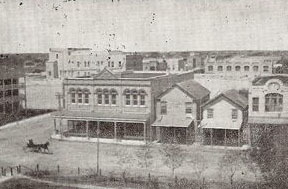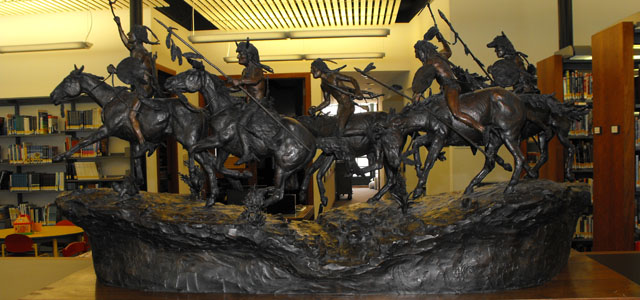The History of Bee County
Bee County is in the Rio Grande plain of south central Texas, fifty miles northwest of Corpus Christi and 146 miles southeast of Austin. It is bordered on the north by Karnes and Goliad Counties, on the east by Refugio County, on the south by San Patricio County, and on the west by Live Oak County. Beeville is the county's largest town and seat of government. The center point of the county is 28°25' north latitude and 97°45' west longitude. Serveral important thoroughfares cross the county, including U.S. highways 59 and 181 and State highways 202 and 359. The county's transportation needs are also served by the Southern Pacific Railroad. An airport built in 1966 serves Beeville and the surrounding region.
Bee County covers 866 square miles that slope gently to the coast. The elevation ranges from 200 to 300 feet. Between 41 percent and 50 percent of the land in the county is considered prime farmland. Most of the area is in the South Texas Plains vegetation region, characterized by open grasslands and scattered shrubs and cacti.
The climate is subtropical and humid, with mild winters and warm summers. Temperatures range in January from an average low of 42° F to an average high of 65° F, and in July from 73° to 96°. The average annual rainfall is thirty inches. There is no snowfall. The growing season averages 275 days per year, with the last freeze in late February and the first freeze in early December. Hurricanes are likely to occur during the late summer.
Bee County has been the site of human habitation for several thousand years. Artifacts recovered in the region suggest that the earliest human inhabitants arrived around 6,000 to 10,000 years ago and camped along the creek valleys. At the time of the first contact with Europeans, various Karankawa bands inhabited the eastern part of the future county, while Lipan Apaches and Borrados roamed the northwest and southwest sections. The Skidi Pawnees left arrowheads in Sulphur Creek near the site of present, Pawnee.
The first Spanish grant in the area was made to Carlos Martinez in 1789 for his services in the king's army at La Bahia and his father's deed of killing an Apache Chief at San Antonio de Bexar Presidio. The first permanent settlers, Jeremiah O'Tool, his sons Martin and Michael, and James O'Reilly, sailed from Ireland in 1826. Women and children arrived in 1829 and helped to establish the community of Corrigan, named for Ellen O'Tool Corrigan's husband. In 1828 William and Patrick Quinn settled in the Power and Hewetson colonu at Papalote Creek, and 1834 settlers from Tipperary, Ireland, landed at Copano Bay and went to the headwaters of the Aransas River (near the site of present Beeville), in the Mcmullen-McGloin colony. Other early residents included Martin De Leon, who established a ranch east of the Aransas in 1805, and the Castillo, Santos, and Moya families, who received Mexican land grants in the area in the early 1830's.
Eleven Bee County landowners, including Timothy Hart, William Quinn, James O'Conner, and James and William St. John, were among the signers of the Texas Declaration of Independence. During the Texas Revolution many of the settlers fled to New Orleans, but most returned, and in the 1840's and 1850's a small buy steady stream of settlers moved to the area. Most took up ranching, which was ideally suited for the broad open expanses of grasslands.
Bee County was established shortly after the settlement of the Cart War, which originated ten miles east of the site of Beeville. The county, named for Benard E. Bee Sr., was formed from San Patricio, Goliad, Refugio, Live Oak, and Karnes counties on December 8, 1857, and officially organized on January 25, 1858, when the first officers were elected. Beeville, the first county sear, was on Medio Creek, near Medio Hill, where the first post office had been established in 1857.
In antebellum Texas the Bee County economy was based almost exclusively on cattle ranching. By 1860 cattle in the county numbered 33,376. Some families grew small crops of corn and other grains, but farming remained on the subsistence level until well after the Civil War. Although the local economy experienced a marked downturn as a result of the conflict, Bee County as a whole was spared the worst effects of the war. By the early 1870s its fortunes began to recover.
In 1880 the census counted 25,030 cattle in the county, and in 1890 the total was more than 32,000. During the decade of the 1870's, sheep ranching was also enjoying a brief heyday. The 1880s saw the beginnings of large-scale agriculture, with corn and oats as the principal crops. In 1870 the county had only twenty-five farms; by 1890 it had 264; and by 1900 the farms numbered 628. In 1895 a state Agricultural Experimental Station was opened near Beeville, which assisted local farmers in selecting appropriate crops and introducing modern farming methods. Corn, flax, peanuts, fruits, vegetables, and onions became the principal products.
The railroads contributed to the rise of the farming economy. The railroads not only opened up new markets outside the county, but also brought large numbers of new settlers. Between 1870 and 1890 the population of the county nearly quadrupled, from 1,082 to 3,720. Over the course of the next twenty years it almost quadrupled again, reaching 12,090 in 1910. Many of the new settlers were recent immigrants, drawn to the area by its mild climate and abundant land. By 1910 nearly a quarter of the county population was foreign born, with new residents from Mexico (1,381) and Germany (188) forming the largest contingents. The growth in population encouraged dramatic growth in agriculture. Between 1900 and 1920 the number of farms in Bee County increased from 628 to 1,497, and agricultural receipts grew nearly fivefold. Cotton, which had been introduced during the 1890s, became a leading crop, and by 1930 the county was producing some 15,000 bales annually. Horse ranching also played an important role in the economy during the first three decades of the century. In 1920 there were more than 5,000 horses on Bee County's ranches, and buyers came from all over South Texas to attend horse auctions in Beeville.
 |
The growing population and expanded farming activity combined to drive up land prices, and during the early 1920s large-scale tenant farming was introduced. By 1930 more than half (1,182) of the county's 1,731 farms were operated by tenants, who came from all strata of society, though, the majority were white. Most were recent arrivals unable to buy land. During the Great Depression of the 1930s, many fell victim to falling prices for agricultural products and to the reluctance of banks to extend credit. By 1940 fewer than half (629) of the tenants who had farmed a decade before were still on the land. |
In 1929 oil and gas were discovered at Pettus, and revenues and jobs from the oil fields helped to offset some of the affects of the depression. But the economy did not begin to recover until World War II, when several military installations were opened in and around Beeville. In 1954 the first United States Navy all-jet based opened at Naval Auxiliary Air Station (now Chase Naval Air Station) in Beeville.
Several small industries-most of them relating to agribusiness-have opened in Beeville and Pettus in the late twentieth century, but the mainstay of the economy remained farming and ranching. Oil and gas extraction form the other mainstay of the local economy. In the early 1990s oil production averaged some 800,000 barrels annually; between 1930 and 1991 crude productions was 99,091,271 barrels. Oil is booming again today.
The first schools opened in the county were opened in 1858. Two of the earliest were located in Papalote and Beeville. In the early 1990s Bee County had four school districts with eight elementary, two middle, and four high schools.
Politically, Bee County has been staunchly Democratic; although Republican presidential candidates won majorities in most late-twentieth-century elections. Democratic officials continued to maintain a virtual monopoly on county wide offices. In the mid 1980s Bee County had forty-five organized churches with an estimated combined membership of 15,748. The largest denominations were Catholic, Southern Baptist, and United Methodist.
*Historical information provided with permission by the Bee County Chamber of Commerce community guide.
